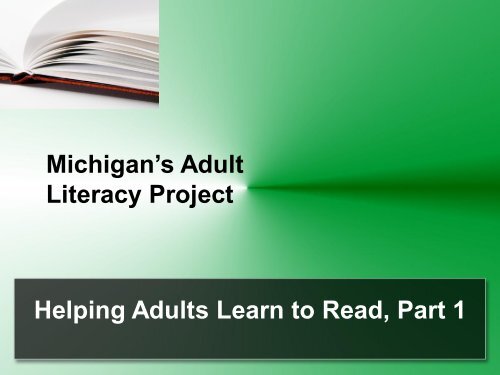Michigan’s Adult Literacy Project Helping Adults Learn to Read, Part 1
Michigan’s Adult Literacy Project Helping Adults Learn to Read, Part 1
Michigan’s Adult Literacy Project Helping Adults Learn to Read, Part 1
You also want an ePaper? Increase the reach of your titles
YUMPU automatically turns print PDFs into web optimized ePapers that Google loves.
<strong>Michigan’s</strong> <strong>Adult</strong><br />
<strong>Literacy</strong> <strong>Project</strong><br />
<strong>Helping</strong> <strong>Adult</strong>s <strong>Learn</strong> <strong>to</strong> <strong>Read</strong>, <strong>Part</strong> 1
Welcome!
Getting Started<br />
This presentation contains audio.<br />
Please adjust your speakers or earphones.
Welcome and Thanks in Advance<br />
So You’ve<br />
Decided <strong>to</strong><br />
Become a<br />
<strong>Literacy</strong> Volunteer
<strong>Helping</strong> <strong>Adult</strong>s <strong>Learn</strong> <strong>to</strong> <strong>Read</strong><br />
<strong>Read</strong>ing – An<br />
Essential Skill<br />
for Life
It All Comes Down <strong>to</strong> <strong>Read</strong>ing<br />
Today a reader,<br />
<strong>to</strong>morrow a leader. Margaret Fuller
How did<br />
you<br />
learn <strong>to</strong><br />
read?<br />
Thinking Back
Components of <strong>Read</strong>ing<br />
Alphabetics<br />
Meaning Skills
Principles of <strong>Learn</strong>ing <strong>to</strong> <strong>Read</strong>ing<br />
• Appreciate written words<br />
• Develop awareness<br />
• <strong>Learn</strong> alphabet<br />
• Understand relationship<br />
• Recognize the<br />
components of language
<strong>Read</strong>ing Vocabulary 101<br />
• Phonemic awareness<br />
– Phonemes<br />
– Graphemes<br />
• Word analysis<br />
– Phonics<br />
• Word Recognition<br />
– Sight words<br />
• Fluency
Phonemes are<br />
Phonemic Awareness<br />
• Smallest unit of sound in a word<br />
• Represented by letters of the alphabet<br />
• Basic sounds of spoken words<br />
You Try It!<br />
How many phonemes<br />
and graphemes in<br />
each of the following<br />
words.<br />
That<br />
Teach<br />
Word<br />
Quick<br />
Craft<br />
<strong>Read</strong><br />
Take<br />
Spell
Phonemic Awareness and Phonics<br />
• Building blocks<br />
• Decoding<br />
Sounds Words Sentences Paragraphs
26 letters <strong>to</strong> learn<br />
44 phonemes <strong>to</strong> worry<br />
about<br />
Phonics<br />
a, b, c, d, e, f, g….<br />
/b/, /c/, /d/, /ā/...<br />
Phonemes-Graphemes-Examples
At the next level,<br />
work on<br />
• Syllables<br />
• Prefixes,<br />
suffixes, and<br />
root words<br />
Phonics
Online Resources – Phonics<br />
ABC Fast Phonics<br />
http://www.abcfastphonics.com/ (free)
Online Resources – Phonics<br />
We All Can <strong>Read</strong><br />
http://weallcanread.com/Online.html#lesso<br />
ns (fee-based)
Identifying Words<br />
It’s not only the use of letter-sound<br />
correspondence <strong>to</strong> recognize words in<br />
print.
Assessing Decoding Skills<br />
Sylvia Greene’s Informal<br />
Word Analysis Inven<strong>to</strong>ry
Decoding Activities<br />
Applying Research in <strong>Read</strong>ing Instruction
Recognizing<br />
Words<br />
• Correctly<br />
• Effortlessly<br />
• Individually<br />
Sight Words<br />
<strong>Read</strong>ing<br />
Fluency
Dolch List<br />
• 220 words<br />
• 50-75%<br />
• Service words<br />
• Hold thoughts<br />
<strong>to</strong>gether<br />
Dolch or Fry<br />
Fry List<br />
• 1000 words<br />
• Updated list<br />
• Ordered by<br />
frequency<br />
• 90%
Assessing Sight Words<br />
Sight Words – Dolch and Fry
Working with Sight Words<br />
<strong>Adult</strong>s must correctly pronounce<br />
words 5-10 times before they<br />
become “sight words”<br />
Dolch Kit - Activities with Sight Words<br />
Fry List – Word Search
The End Goal – Sight Words<br />
Sight words include any word that readers<br />
have practiced reading sufficiently often <strong>to</strong><br />
be read from memory” (Ehri, 2002)
What’s Your <strong>Read</strong>ing Rate?<br />
Take this test and see!<br />
http://mindbluff.com/askread.htm
<strong>Read</strong>ing Rate and Fluency<br />
<strong>Read</strong>ing rate<br />
<strong>Read</strong>ing fluency
• Assessing<br />
• Improving<br />
<strong>Read</strong>ing Rate
<strong>Read</strong>ing Rate a
<strong>Read</strong>ing Rate and Fluency<br />
Three elements that<br />
compose fluent reading:<br />
• Rate (fast decoding)<br />
• Accuracy<br />
• <strong>Read</strong>ing with proper<br />
rhythm, in<strong>to</strong>nation, and<br />
expression<br />
http://www.ldonline.org/article/6354<br />
http://www.prel.org/products/re_/as<br />
sessing-fluency.htm<br />
Average Rates for <strong>Read</strong>ing with<br />
Understanding<br />
Grade<br />
Equivalent<br />
Standard Words Per Minute<br />
2.5 121<br />
3.5 135<br />
4.5 149<br />
5.5 163<br />
6.5 177<br />
7.5 191<br />
8.5 205<br />
9.5 219<br />
10.5 233<br />
11.5 247<br />
12.5 261
They Have <strong>to</strong> Believe<br />
A belief by learners that they can be<br />
successful when attempting new activities<br />
as learners.
Two main components of reading<br />
• Alphabetics<br />
• Meaning skills<br />
Quick Review<br />
Mastering alphabetics is essential learning <strong>to</strong><br />
read<br />
• Phonemic awareness<br />
• Phonics<br />
• Decoding<br />
• Word Recognition<br />
• Sight words<br />
• <strong>Read</strong>ing fluency leads <strong>to</strong> improved<br />
comprehension
More Tu<strong>to</strong>rials and Resources<br />
<strong>Helping</strong> <strong>Adult</strong>s <strong>Learn</strong> <strong>to</strong> <strong>Read</strong>, <strong>Part</strong> 2<br />
• Strategies and resources for building<br />
vocabulary and comprehension<br />
Writing – An Essential Skill<br />
• Strategies and resources <strong>to</strong> help students<br />
move from sentences <strong>to</strong> paragraphs<br />
Numeracy – <strong>Helping</strong> Students Gain a Strong<br />
Foundation
This project was developed by<br />
National Human Resources Development, Inc.<br />
(NHRD) in cooperation with the<br />
Michigan Economic Development Corporation,<br />
Workforce Development Agency State of Michigan,<br />
Office of <strong>Adult</strong> <strong>Learn</strong>ing<br />
and funded through a grant under<br />
the Wagner-Peyser Act.<br />
For more information visit:<br />
http://www.maepd.org<br />
33


